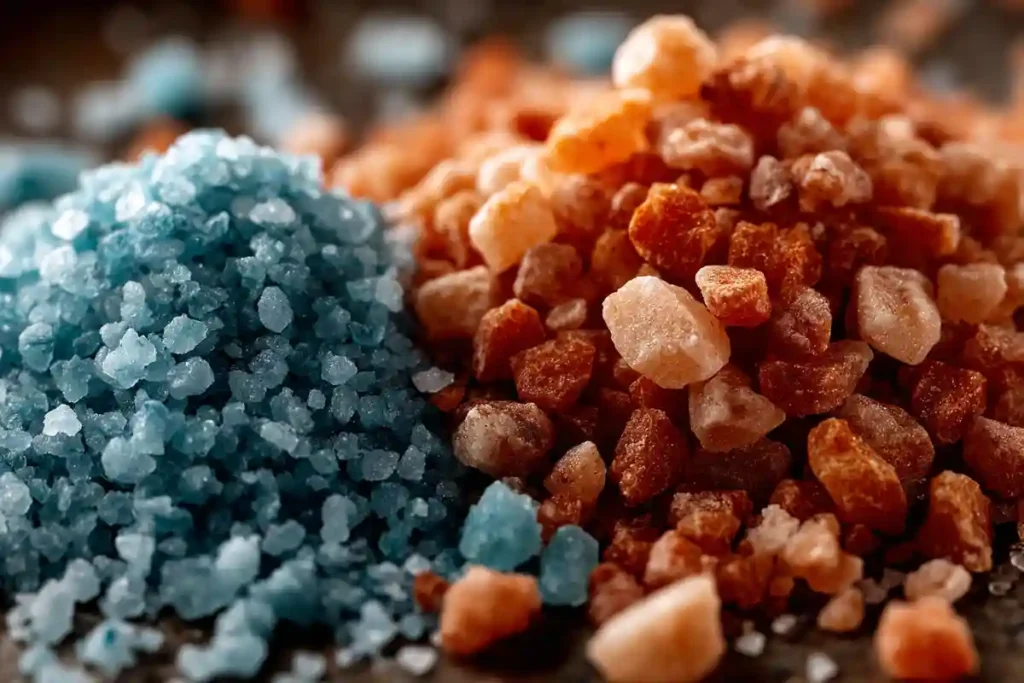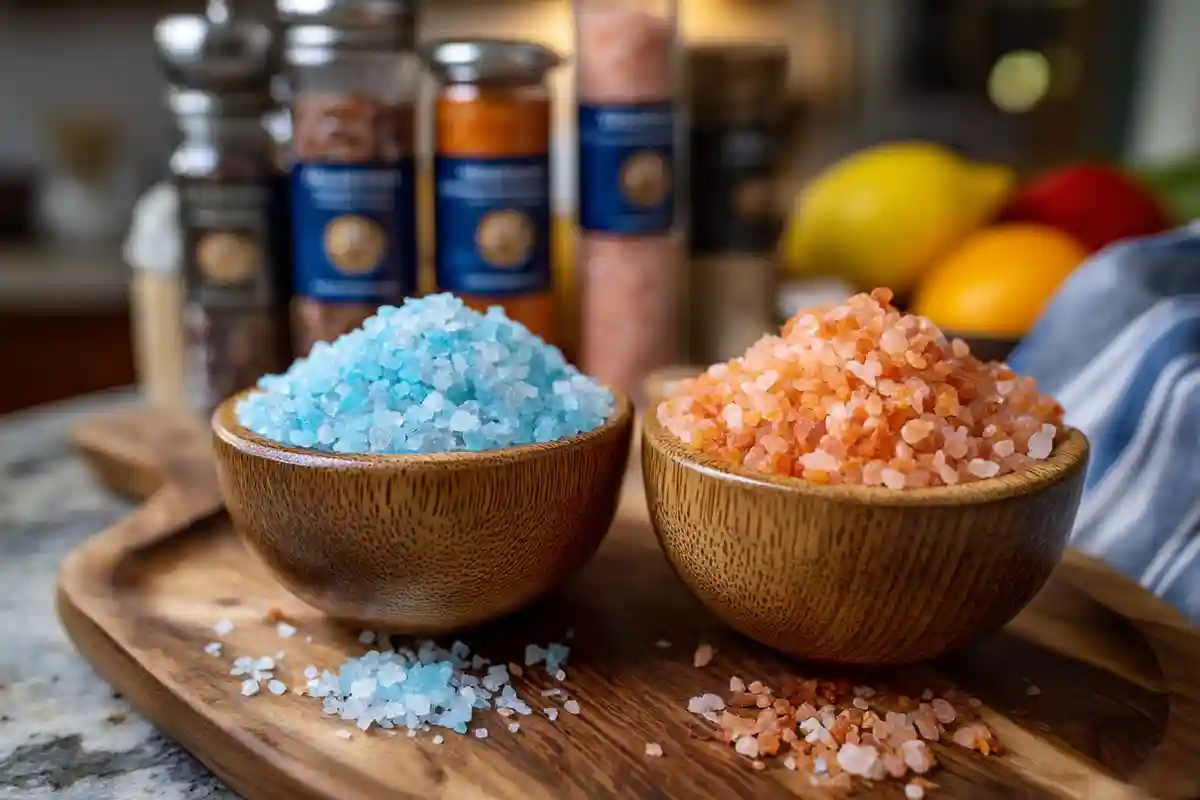Persian Blue Salt vs. Himalayan Pink Salt – Which is Better? It’s a question that’s been swirling in wellness circles, recipe blogs, and even in my own kitchen. I’m Samantha Rivera—mom of two, cozy cook here in sunny San Diego, and the voice behind Yummy Crafter. Like many of you, I’ve always been curious about those beautifully colored salts that seem to promise a little extra magic in every pinch.
I remember the first time I tried Persian blue salt: its shimmering crystals looked like tiny gemstones in my hand. The taste was delicate, almost sweet, and it felt like a mini luxury to sprinkle over fresh salads or stir into my morning hydration ritual. Then came the Himalayan pink salt—its soft, rose-tinted hue and earthy flavor quickly made it a staple in my kitchen. But I couldn’t help but wonder: when it comes to health, hydration, and flavor, which one truly deserves a spot in my daily routine?
If you’ve been asking the same question—wondering if one salt is better for wellness, recipes, or just your own peace of mind—you’re in the right place. In this deep dive, we’ll explore what sets these two salts apart, their unique benefits, and how to choose the one that fits your life best.
Let’s dive in and discover the beautiful, mineral-rich world of Persian blue salt and Himalayan pink salt—and why each one has its own special role in the kitchen and beyond.
What is Persian Blue Salt?
Persian blue salt is one of the rarest and most visually striking salts in the world. Harvested from ancient salt mines in Iran, this salt gets its distinctive blue color from the natural mineral content—particularly potassium and magnesium trapped in the crystal structure.
What makes it special isn’t just the color, though. Persian blue salt has a mild, almost sweet flavor with a crunchy texture that makes it perfect for finishing dishes. Its subtle taste doesn’t overpower food, making it a favorite among chefs and home cooks alike.
I first added this salt to my own kitchen as part of a hydration ritual—a pinch dissolved in water or milk to create a mineral-rich wellness drink that feels like a mini spa moment. But Persian blue salt also shines when sprinkled over salads, roasted vegetables, or even desserts, adding a touch of elegance to everyday meals.
What is Himalayan Pink Salt?
Himalayan pink salt comes from the ancient salt mines in the foothills of the Himalayas, primarily in Pakistan. This salt is famous for its soft pink color, which comes from the presence of trace minerals like iron and magnesium.
When you taste it, Himalayan pink salt has a more robust, earthy flavor compared to Persian blue salt. It’s often used as an all-purpose cooking salt, perfect for seasoning everything from soups and stews to grilled meats and vegetables. Many people also love it for finishing dishes, adding a subtle crunch and a pop of color.
In my kitchen, Himalayan pink salt has become a pantry staple—one I reach for when I want to add depth and balance to savory dishes. It’s also become popular in wellness circles, used in everything from bath soaks to salt lamps, thanks to its natural mineral content and grounding vibe.
Key Differences Between Persian Blue Salt and Himalayan Pink Salt

When it comes to comparing Persian blue salt and Himalayan pink salt, there are some key differences that make each one unique.
✅ Color & Visual Appeal
Persian blue salt has a dazzling blue hue that almost looks like gemstones. It’s striking and elegant—perfect for adding a touch of visual magic to dishes. Himalayan pink salt, on the other hand, has a warm, rosy color that feels earthy and grounding.
✅ Flavor Profile
The taste of Persian blue salt is mild and delicate, with a subtle sweetness that works well as a finishing salt. Himalayan pink salt has a more robust, earthy flavor—making it a great choice for everyday cooking and seasoning.
✅ Texture & Crunch
Both salts have a satisfying crunch when used as finishing salts, but Persian blue salt crystals are slightly larger and can create a more dramatic texture when sprinkled over dishes.
✅ Mineral Content
Both salts are rich in minerals like potassium, magnesium, and calcium, but Himalayan pink salt has a slightly higher iron content, giving it that signature pink color. Persian blue salt is prized for its potassium-rich crystals, which can help support hydration and muscle function.
✅ How They’re Used
- Persian blue salt: Best as a finishing salt for salads, desserts, and fancy plating. Also popular in wellness drinks like the Blue Salt Trick.
- Himalayan pink salt: Great for cooking, seasoning, and even wellness rituals like bath soaks and salt lamps.
Wellness Benefits – Which One is Better?

Both Persian blue salt and Himalayan pink salt have found their place in the world of wellness, but they each bring something unique to the table.
✅ Persian Blue Salt: The Hydration Hero
Thanks to its high potassium content, Persian blue salt can help with electrolyte balance—an essential part of hydration and recovery. It’s become a favorite in drinks like the Blue Salt Trick, where a small pinch can make a big difference in how your body feels after a workout or on a busy day.
✅ Himalayan Pink Salt: The All-Purpose Mineral Boost
Himalayan pink salt’s balanced mineral profile makes it great for everyday cooking and wellness rituals. It’s also used in salt lamps and bath soaks—believed by some to help clear negative energy and create a calming atmosphere.
✅ Which One is Better?
The answer depends on your goals. If you’re looking for a gentle hydration ritual, Persian blue salt can be a beautiful and effective choice. But if you want an all-around mineral boost for your meals and wellness routine, Himalayan pink salt is a versatile, reliable option.
For me, it’s not about choosing one over the other—it’s about knowing how to use each salt to support your health and add a little magic to your daily routine.
Curious to try these salts in a refreshing wellness drink? Here’s my step-by-step Blue Salt Trick Recipe to bring these minerals to life in your kitchen.

Blue Salt Trick Hydration Drink
Equipment
- Glass or mug
- Spoon
Ingredients
- 1 cup water or plant-based milk room temperature or chilled
- 1/2–1 tsp authentic Persian blue salt
- 1–2 slices fresh lemon optional
- 1 tsp honey or maple syrup optional, for added sweetness
- fresh mint leaves for garnish (optional)
Instructions
- Pour the water or plant-based milk into a glass.
- Add the Persian blue salt and stir thoroughly until fully dissolved.
- Add fresh lemon slices and honey if desired, and stir again.
- Garnish with fresh mint leaves for a refreshing finish.
- Enjoy your naturally hydrating and mineral-rich drink!
Notes
My Personal Experience – Samantha’s Take
As a busy mom of two and someone who loves turning everyday moments into small rituals of self-care, I’ve found both Persian blue salt and Himalayan pink salt have their own special roles in my kitchen and wellness routine.
Persian blue salt first caught my eye with its gem-like color. There’s something almost magical about watching those blue crystals swirl and dissolve in my morning hydration ritual. I use it in my wellness drinks when I need an extra push to stay hydrated, and it always feels like a treat—like a tiny luxury in a glass.
Himalayan pink salt, on the other hand, is my kitchen workhorse. From seasoning roasted veggies to adding that final touch on a grilled steak, it’s the salt I reach for when I want a balanced, earthy flavor that complements everything. I also love using it in relaxing baths after a long day—it feels like a warm hug for my body and mind.
For me, there’s no “winner” here. It’s about finding which salt fits your mood and goals each day. That’s what makes these natural salts so special: they’re not just ingredients, they’re small ways to care for yourself.
FAQs
Q1: Which salt has more minerals, Persian blue or Himalayan pink?
A: Both salts are rich in minerals like potassium and magnesium. Himalayan pink salt has slightly more iron, while Persian blue salt stands out for its high potassium content.
Q2: Can I use these salts in cooking?
A: Absolutely! Himalayan pink salt is great for everyday cooking. Persian blue salt, with its delicate flavor and crunch, shines as a finishing touch for salads, veggies, and desserts.
Q3: Are these salts safe for everyone?
A: Generally yes, in moderation. If you have kidney issues or high blood pressure, check with your doctor before adding more salt to your routine.
Q4: Do these salts help with weight loss?
A: They’re not magic weight-loss tools, but their mineral content can help with hydration and reduce cravings—key parts of a healthy lifestyle.
Q5: Where can I buy authentic Persian blue salt?
A: It can be harder to find than pink salt, so look for trusted sources online or specialty spice shops. Always check for authenticity!
Nutrition & Safety Notes
Both Persian blue salt and Himalayan pink salt are natural sources of essential minerals, but it’s always smart to know what you’re consuming—especially if you’re using them as part of your daily wellness routine.
✅ Approximate Nutrition Facts (per serving)
| Nutrient | Amount (approx.) |
|---|---|
| Sodium | 300–400 mg |
| Potassium | Trace amounts (higher in blue salt) |
| Magnesium | Trace amounts |
| Iron | More in pink salt |
| Calories | 0 kcal |
✅ Safety Tips:
- Use these salts as a finishing touch or in small amounts. A little goes a long way!
- If you have high blood pressure or kidney issues, talk to your doctor before adding more salt to your diet.
- Authenticity matters—look for trusted sources to ensure you’re getting real Persian blue salt or Himalayan pink salt.
✅ Why This Matters:
Knowing these nutrition basics and safety tips can help you enjoy the beauty and benefits of these natural salts—without overdoing it!
Conclusion & Takeaway
Persian blue salt vs. Himalayan pink salt— two beautiful, mineral-rich salts that can both add a little extra magic to your daily routine. For me, it’s never been about choosing one or the other. It’s about knowing how to use each to support your health, enhance your meals, and make even the simplest moments feel special.
✅ Key Takeaway?
Persian blue salt’s mild flavor and stunning color make it perfect for hydration rituals and elegant finishing touches. Himalayan pink salt, with its earthy taste and versatility, is a pantry staple that works for almost everything.
👉 Ready to try them out?
Start with a pinch—add a pop of color to your meals or a mindful moment to your day. And if you’re curious to explore how to integrate these natural salts into your wellness rituals, check out my complete Blue Salt Trick Recipe here.


